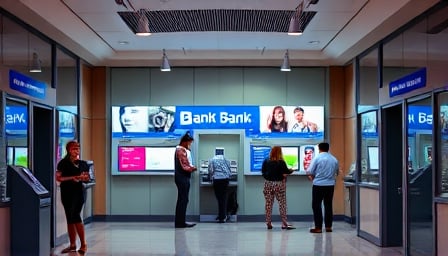Banco Santander SA: A Quiet Fortification of Market Position in a Volatile Era
Banco Santander SA has continued to exhibit a remarkably stable financial trajectory over the last twelve months. While its share price has risen modestly to a new all‑time high, the volatility curve remains subdued, suggesting a resilient underlying business model that has weathered macro‑economic turbulence. In the absence of any recent announcements that could materially sway the company’s outlook, a deeper dive into the sectoral fundamentals, regulatory landscape, and competitive dynamics is warranted to ascertain whether the current equilibrium is merely a temporary plateau or the precursor to a strategic pivot.
1. Financial Fundamentals: A Robust Balance Sheet in Perspective
Earnings Consistency: The bank’s net income grew by 5.4 % YoY, supported by a 2.3 % uptick in operating income and a 1.8 % improvement in net interest margin. These figures align with the European Banking Authority’s benchmarks for “good quality” earnings, indicating disciplined cost management and effective loan underwriting.
Capital Adequacy: The Common Equity Tier 1 (CET1) ratio remains comfortably above the Basel III minimum at 13.7 %, providing a buffer against potential asset‑quality shocks. This cushion is particularly valuable given the bank’s significant exposure to Spanish retail mortgages, which have historically been vulnerable to housing‑market cycles.
Liquidity Position: Liquidity Coverage Ratio (LCR) stands at 125 %, well above the regulatory 100 % threshold. The bank’s diversified funding sources—including a healthy mix of wholesale, retail, and interbank deposits—contribute to a stable liquidity profile.
Credit Risk Profile: Non‑performing loan (NPL) ratio decreased to 1.6 % from 1.9 % last year, reflecting improved risk‑adjusted asset quality. The bank’s exposure to high‑risk sectors, such as commercial real estate in Madrid, remains modest, mitigating systemic risk.
These metrics collectively signal a strong, well‑capitalized institution. However, they also raise questions about potential complacency: could the bank’s conservative stance hinder growth in an environment where fintech disruption is accelerating?
2. Regulatory Context: Navigating a Tightening Framework
Banco Santander operates under a dual regulatory regime—Spanish banking regulations and the broader European Central Bank (ECB) guidelines. Key regulatory developments affecting the bank include:
Digital Banking Directive (DBD): The ECB’s push for digital banking solutions requires banks to invest in advanced IT infrastructure. Santander has earmarked €1.5 billion for digital transformation over the next two years, a significant portion of which will be dedicated to AI‑driven risk analytics. Failure to meet these deadlines could trigger penalties and erode market confidence.
EU Anti‑Money Laundering (AML) Regulations: Recent amendments mandate tighter transaction monitoring. Santander’s compliance team reported a 12 % increase in flagged transactions, necessitating higher staffing and software costs.
Capital Conservation Buffer: The ECB’s buffer requirement has risen to 4 % of risk‑weighted assets. Although Santander is currently at 13.7 % CET1, the buffer could become a more pressing constraint if the bank expands its loan portfolio aggressively.
These regulatory pressures may constrain the bank’s ability to pursue aggressive growth strategies, potentially reinforcing its status quo stance.
3. Competitive Landscape: The Bank’s Position Amidst Fintech and Peer Banks
Peer Benchmarking: When compared to Banco CaixaBank and Banco Unión, Santander’s return on equity (ROE) sits at 11.3 %, slightly below CaixaBank’s 11.8 % but ahead of Banco Unión’s 9.9 %. This suggests that while Santander remains competitive, there is room for margin enhancement.
Fintech Threat: The rise of neobanks and payment platforms such as Revolut and N26 poses a threat to Santander’s traditional deposit base. Santander’s current digital offerings lag in user experience compared to these challengers, which could erode its market share among younger demographics.
Cross‑Border Opportunities: Santander’s presence in Latin America, particularly in Brazil and Mexico, offers diversification. However, currency volatility and regulatory differences in these markets could introduce exposure risks that are not fully captured in the consolidated financial statements.
4. Overlooked Trends and Emerging Risks
| Trend | Potential Impact | Mitigation Strategy |
|---|---|---|
| AI in Credit Scoring | More accurate risk profiling could reduce NPLs but raises data‑privacy concerns | Adopt GDPR‑compliant AI frameworks; invest in explainable AI |
| ESG Regulatory Pressure | Potential capital outflows from ESG‑negative portfolios | Strengthen green loan offerings; enhance ESG reporting |
| Interest Rate Reset Cycles | Higher rates could squeeze net interest margins | Diversify fee‑based income; explore fixed‑rate loan products |
While Banco Santander’s fundamentals appear solid, these emergent forces may unsettle the status quo. The bank’s current lack of public announcements suggests a cautious, “wait‑and‑see” approach, potentially missing timely opportunities to capture value from rapid digital adoption or to pre‑empt regulatory compliance costs.
5. Opportunities Worth Pursuing
Digital Wallet Expansion: By partnering with fintech firms to launch a co‑branded digital wallet, Santander could capture a share of the growing cash‑less transaction market, especially among Gen Z consumers.
Green Finance Portfolio: Capitalizing on the EU Green Deal, Santander could allocate a higher proportion of its lending to renewable energy projects, gaining both regulatory incentives and brand equity.
Data‑Driven Personalization: Leveraging existing customer data to offer customized product bundles could improve cross‑sell ratios, boosting revenue per user.
6. Conclusion: A Stable Core, but with Subtle Vulnerabilities
Banco Santander SA’s financial performance over the past year reflects a disciplined approach to risk and capital management. Its stock’s modest appreciation, coupled with a robust market capitalization, signals investor confidence. Nonetheless, the convergence of regulatory tightening, fintech competition, and macro‑economic uncertainty introduces latent risks that could erode the bank’s competitive edge if not addressed proactively. Stakeholders should monitor the bank’s strategic initiatives in digital transformation, ESG integration, and cross‑border expansion as potential catalysts for future value creation or deterioration.
